The Samsung Galaxy Note5 and Galaxy S6 edge+ Review
by Joshua Ho on October 2, 2015 8:00 AM ESTBattery Life
Battery life is undoubtedly one of the most important parts of the user experience of any mobile device. One of the major reasons why many people use phablets is to get better battery life, as the PCB size of a phablet is often roughly similar to what you’ll see in a smartphone, but the battery will be bigger to fill the available space. As a result, a phablet has a higher proportion of battery than a smartphone. This inherently means that battery size will scale faster than platform power. In order to test this metric, we use a number of different tests ranging from display-bound web browsing to SoC-bound CPU and GPU load tests. In order to eliminate confounding variables, we test all devices from the same ASUS RT-AC68U router for WiFi testing, and in strong LTE/3G reception for mobile web browsing, in addition to setting all devices to an average of 200 nits on the display.
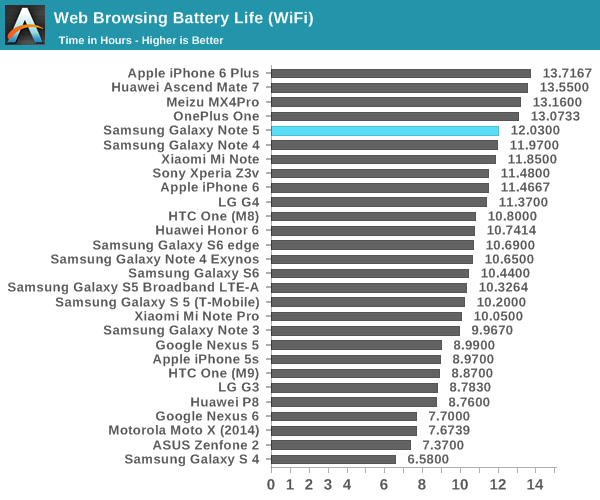
In our first test of WiFi web browsing, the Galaxy Note5 performs identically to the Galaxy Note 4. This might be surprising because the display is the same size and resolution as the Galaxy Note 4 with a smaller battery than the Galaxy Note 4. However, the smaller battery is compensated for due to improvements in SoC and display efficiency. In particular, the move from a planar 28nm process to a 14nm FinFET process dramatically reduces power consumption on the SoC.

In LTE battery life, we see a noticeable drop relative to WiFi battery life. It’s likely that this is mostly due to the power consumption of the Shannon 333 modem present in these devices. There’s not much else to say here, but battery life is still good.
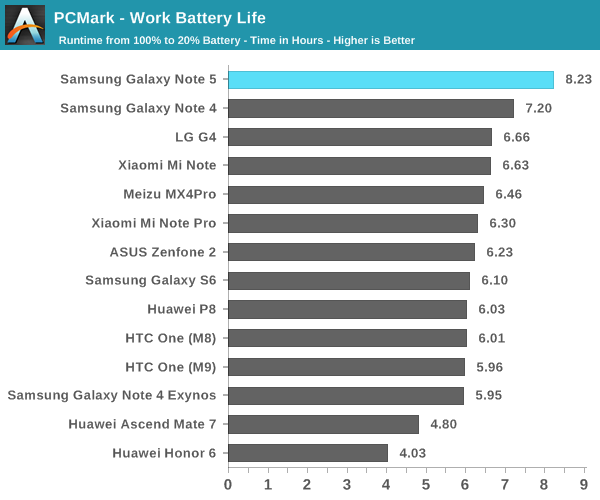
Moving past our mostly display-bound web browsing test, PCMark provides a much more balanced look at battery life as APL tends to vary a bit more with content like videos and photos instead of just webpages, and the CPU component is much more strongly emphasized. Here we can really see the Note5’s Exynos 7420 stretch its legs as it keeps a high performance level with long runtime.
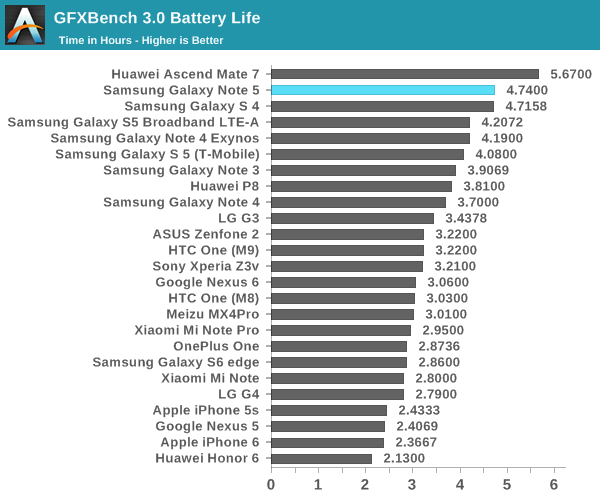
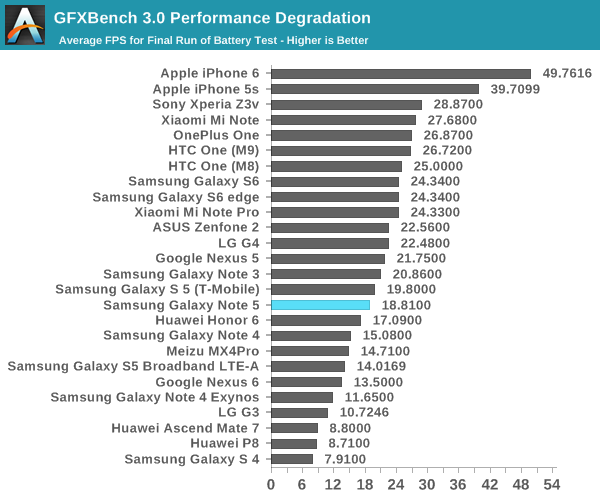
In our sustained SoC-bound workloads, GFXBench shows a healthy improvement over the Galaxy S6. Although we’re unable to test in perfectly controlled temperatures, it looks like Samsung has improved the throttling behavior of the SoC as the throttling appears to be more graceful rather than sinusoidal, and the result is a pretty significant jump in runtime over most devices.
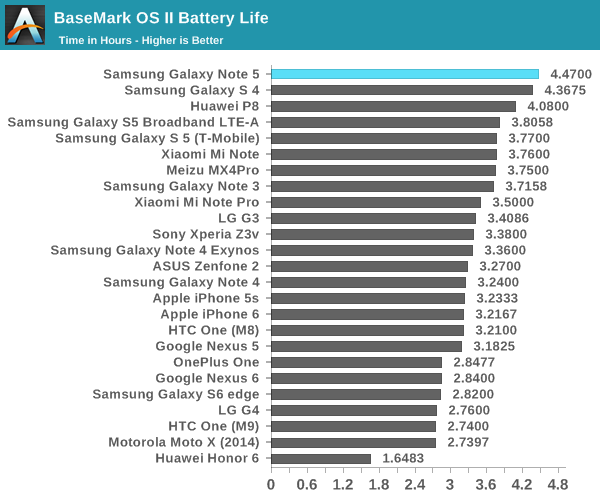

In Basemark OS II, we see a pretty significant uplift in runtime when compared to something like the Galaxy S6 or Note 4. The runtime increase isn’t just due to excessive throttling though, as the battery score shows that this isn’t just a case of throttling the CPU until the runtime is an improvement over past devices.
Overall, if you’ve read the Galaxy S6 review it’s pretty fair to say that you’ll know what to expect from the Galaxy Note5. Battery life is roughly equivalent to the Galaxy Note 4 despite the smaller battery, and due to the greatly improved Exynos 7420 SoC relative to 2014 SoCs SoC-bound cases will show pretty healthy improvements as long as you’re controlling for performance.
Charge Time
While normally battery life is the primary area of concern for a smartphone, in some cases it’s important for a phone to charge quickly. We can all claim to be perfect but one of the simplest cases for faster charging is forgetting to plug the phone in before going to sleep, so the maximum allowable charge time goes from something like 6 hours to an hour at best. As a result, a faster charger can dramatically improve practical battery life in any situation where you have limited time to charge. This can be accomplished by increasing either the current or voltage of the charger. The original quick charging standards improved charge rate through higher current, but this eventually hits a wall due to resistance in the wire. In order to increase the total amount of power delivered without increasing the thickness of the cable used voltage was increased in the case of newer standards like QC 2.0. In the case of the Galaxy Note5 and Galaxy S6 edge+, we’re looking at the same 9V, 1.67A QC 2.0 compatible charger that shipped with the Galaxy Note 4. In order to test this properly, we log the time it takes for the phone to charge by running a timer until the charger power draw hits a point that represents 100% battery.
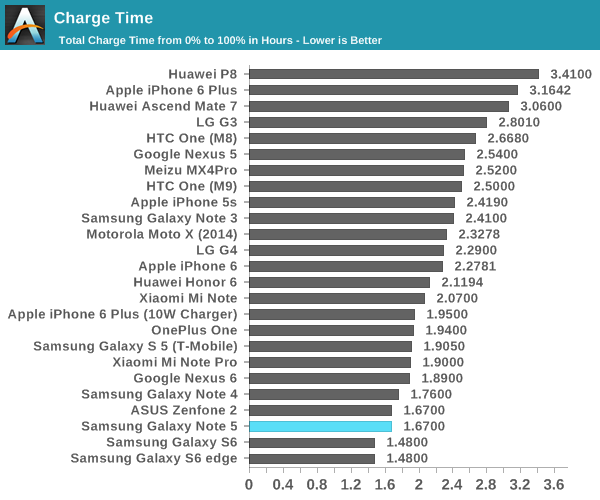
It probably isn’t a surprise, but charge time ends up similar to the Galaxy S6 and Galaxy Note 4. I suspect that we’ll be waiting until QC 3.0 to be able to see significant improvements as the current standard doesn’t have particularly fine-grained voltage scaling according to cable and phone conditions. Interestingly, the wireless fast charger is actually not too far off from the wired charger as it indicates 100% around 1.84 hours into charging which is almost identical to the wired fast charger.


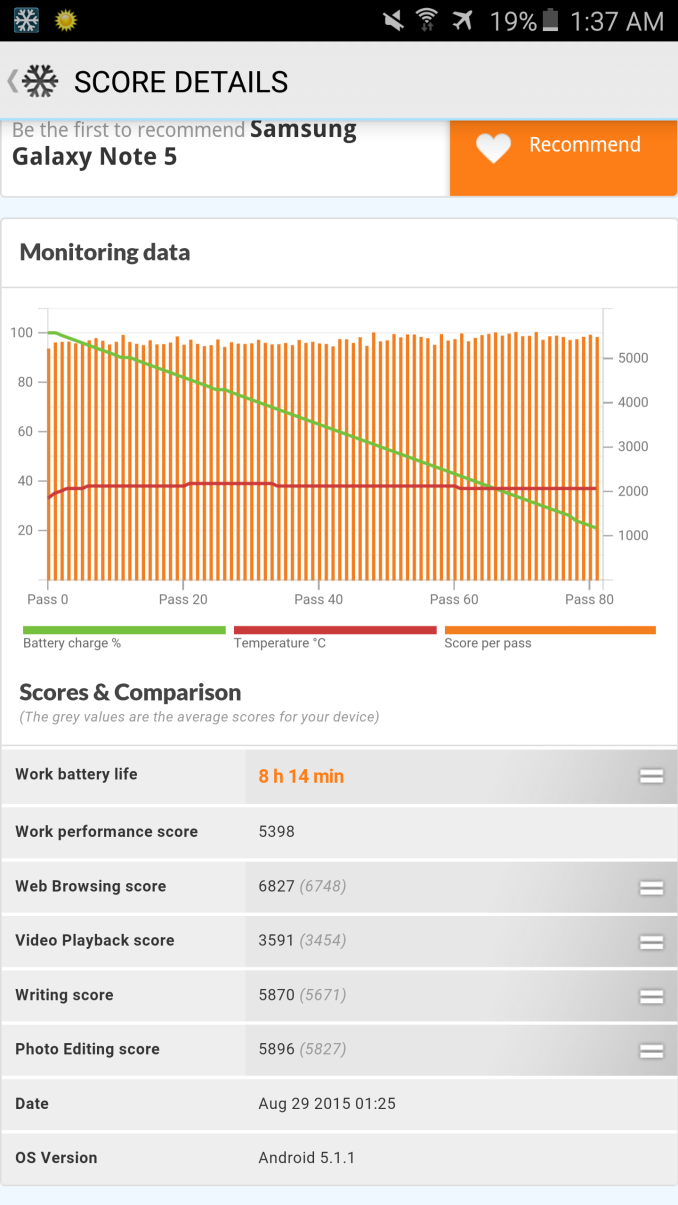
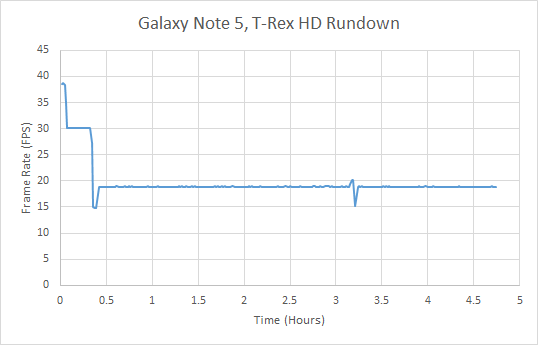
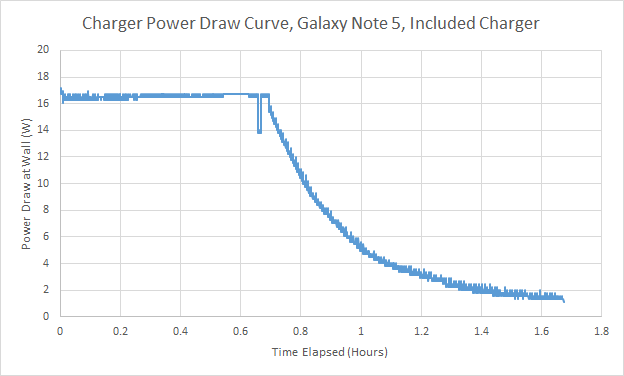
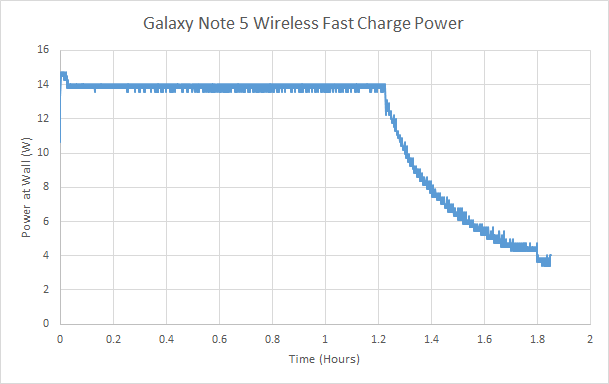








225 Comments
View All Comments
osxandwindows - Saturday, October 24, 2015 - link
People don't buy the iPhone because of that.You must be one your self to call people who by them a sheep.
lucam - Friday, October 2, 2015 - link
Why you haven't add the iPhone 6s results? Are you still updating the bench?Ryan Smith - Friday, October 2, 2015 - link
The iPhone 6s is still being reviewed. This was actually completed ahead of the 6s launch, though we had to hold off on publishing it for a few days.lucam - Friday, October 2, 2015 - link
Fair enough, thanks.harrietpubman - Friday, October 2, 2015 - link
Is there any timeline for when the 6s/6s+ review will be completed and published? Next week perhaps?Kuzi - Friday, October 2, 2015 - link
Their Apple overlords ordered iAnandtech to hold off publishing the Note 5/Edge 6 + review until iPhone6S/6S+ are released as to not jeopardize their sales.ws3 - Friday, October 2, 2015 - link
If that were true then their Apple overlords would also have ordered them to include the iPhone 6s benchmark results to show the Exynos 7420 being crushed by the A9. Since that didn't happen, your assertion is wrong.Kuzi - Friday, October 2, 2015 - link
They did just that few days ago by showing preliminary iPhone 6S benchmarks.A9 GPU is much faster yes, but CPU is faster only on single/dual apps/benchmarks. Android utilizes quad-cores when running apps as shown on Anandtech last month, so CPU performance for exynos 7420 or Snapdragon 810 should be able to match or beat that of the A9.
tipoo - Friday, October 2, 2015 - link
Android uses 8 cores well - that article also showed apps themselves don't. Games and such which need the performance most, usually don't use more than 3-4, even if Android is good at using 8.Morawka - Friday, October 2, 2015 - link
because most arm soc's never use 8 cores all at once.. it's big.Little.. 4 core for high performance, then 4 core for mundane task